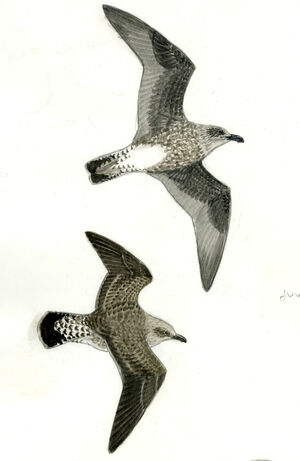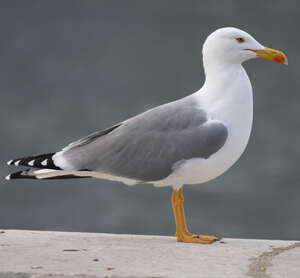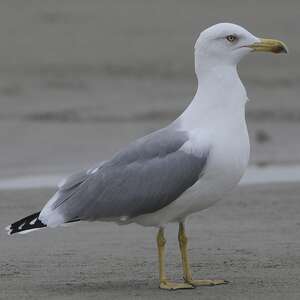Yellow-legged Gull
Larus michahellis - Goéland leucophée
Identification
The Yellow-legged Gull is a relatively large, robust gull, not very tall on legs, in size roughly similar to that of the Herring Gull and the Black-headed Gull. Sexual dimorphism only plays out in size, with the male being significantly larger than the female. Identification of adults in nuptial plumage presents no problem when well seen. It is grey on top and white underneath like the others. It is the shade of the grey of the upper parts that is important. The grey of the nominate subspecies of the Yellow-legged Gull, the michahellis, is intermediate between that of the Herring or Black-headed Gull, a little lighter, and that of the Lesser Black-backed Gull, distinctly darker. Then follows the color of the bill and legs, which in the Yellow-legged Gull is a bright yellow in the nuptial period. The bill has an important aspect, is stouter and taller than in the others. It has a red patch at the lower mandible at the gonydeal angle, like all large gulls, but may perhaps be brighter in this one and more diffuse on the adjacent upper mandible. The corner of the bill is likewise red. The eye has a light yellow iris, which makes it well visible, and it is surrounded by a bright red orbital circle. On a flying bird, one must pay attention to the pattern of the end of the wing. The 5 last primary remiges (numbered in descending order, P5 to P10) grey have black at their tip, in decreasing quantity from P10 to P5. To this end of the wing, one must note the distribution of the white, which is specific. The outermost/anterior one, P10, largely black, is white at its tip, with a small black subterminal bar sometimes absent. P9 reproduces a similar scheme but the white tip is less long and the subterminal black bar much more important, thus inverting the proportions in favour of the black. Finally, the P8 to P5 have less and less black and just have a white spot at their tip.The atlantis subspecies of the Macaronesian Islands has much darker upper grey, approaching that of graellsii ssp G. brun, from which possible confusions arise. The Yellow-legged Gull becomes adult in its fourth year, passing through complex immature plumages that are quite close to the equivalent plumages of other species, making it difficult to sort out. Therefore, we will not approach this subject by risking confusing the reader, and send them to the images of the gallery, which are self-explanatory. Suffice it to say that the shade of grey in the upper parts, once it appears in the second year, is of great importance in the analysis.
Let's simply look at the newly fledged juvenile. It appears brown with a pale head. The upper parts are brown, darker than the young silver and paler than the brown. All the feathers have a whitish-beige edge, giving a clearly scaled appearance. The tertials, same brown, have a whitish and serrated edge that is well visible. The underparts are whitish and mottled with light brown on the chest and flanks. The head and neck are finely striped of the same colour, explaining their lighter aspect. The dark eye is set in a darkened area with a dark brown arch in front of it. The bill is blackish and the legs are rosy. In flight, note the wing pattern. The remiges are dark brown without a clearer window marked at the level of the inner primaries. In the overhead view, the outer coverts are darkened, outlining a second dark wing band that partially doubles the full dark band of the secondary remiges. The young silver has a clear window and a single dark bar. On the other hand, the young Pontic can easily be mistaken for this age. It has a very clear underside of the wing while the leucophée has a distinct brown.One must also take into account the shape (higher on legs, more bulging chest, longer neck, receding forehead) of the Yellow-legged Gull.
Subspecific information 2 subspecies
- Larus michahellis michahellis (w and s Europe, nw Africa, Mediterranean)
- Larus michahellis atlantis (Azores, Madeira and Canary Is.)
Foreign names
- Goéland leucophée,
- Gaviota patiamarilla,
- gaivota-de-patas-amarelas,
- Mittelmeermöwe,
- sárgalábú sirály,
- Geelpootmeeuw,
- Gabbiano reale,
- medelhavstrut,
- Gulbeinmåke,
- čajka žltonohá,
- racek středomořský,
- Middelhavs-sølvmåge,
- etelänharmaalokki,
- gavià de potes grogues,
- mewa romańska,
- Vidusjūras kaija,
- rumenonogi galeb,
- Средиземноморская чайка,
- キアシセグロカモメ,
- 黄腿银鸥,
- medelhavstrut,
- 黃腿鷗,
Voice song and call
Habitat
During the breeding season, the Yellow-legged Gull occupies the coastal areas of the Atlantic Ocean (from the Loire to southern Morocco and around the Macaronesian islands) and the Mediterranean and its islands. It nests in colonies on sea cliffs and steep slopes covered with vegetation, coastal dunes, rocky or sandy islands, lagoons, coastal marshes, salt pans and increasingly in urban environments, for example on roofs. It mainly feeds in the intertidal zone. It is also found in continental situations at the edge of very large bodies of water such as Lake Geneva, in some large river valleys such as the Rhône or the Rhine, as soon as there are islands or islets suitable for nesting.
Outside the breeding season, the species is distributed in large numbers along the coasts, particularly in port areas where provender is more abundant. It also makes foraging incursions inland, for example in cultivated areas with Herring Gulls. The large inland bodies of water also have their winter birds that feed both on the water due to fish mortality and in the surrounding agricultural lands. Some birds have specialized and are, during the entire bad season, detritivorous linked to technical bulk storage centers CBT where the resource is great. There they find many other scavengers such as corvids, starlings and other gulls, especially the Herring Gull.They still need water nearby to drink, wash and spend the night.
Behaviour character trait
Populations can be erratic or sedentary. Post-nuptial movements to wintering grounds occur from July to November, with return migration taking place from mid-February to mid-June.
The species breeds in a colonial manner in groups reaching up to 8,000 couples. Outside of the breeding season, the species remains gregarious, gathering around ports, towns and dumps.In cities, the Yellow-legged Gull is not welcomed. Its call can be annoying and its droppings can soil, especially when it nests on buildings.
Due to its local abundance, the Yellow-legged Gull can be clearly a nuisance, for example when it takes from colonies of rare birds, as in the Macaronesian Islands with the small procellariiforms. In such conditions, population control is carried out.
Flight
Dietfeeding habits
The Yellow-legged Gull is an opportunistic predator/scavenger. Its diet consists of fish, both living and dead, aquatic invertebrates (molluscs, crustaceans), and land-based invertebrates (large insects, worms, small mammals such as field mice, birds).
As mentioned above, it has a taste for human waste (CET). It is also well-known in the summer for raiding colonies of seabirds such as terns and gulls, or small procellarisfom mores on Atlantic islands. The populations of some of these, such as the frigate petrel, are fragile and do not need this negative factor in their demography.Reproduction nesting
The breeding season begins in mid-March and extends until July across the range. Normally only one clutch is laid per season.
The species breeds either in monospecific or mixed colonies, usually close to water, but sometimes up to several hundreds of meters away from it. The pairs nest usually a few meters away from each other. The nest is built by the couple using elements of the surroundings, such as grass, algae, feathers and various debris collected on the seashore. Its composition is therefore very variable and it is usually protected by vegetation.The clutch generally consists of 2-3 eggs (1-4) of very variable colours. Incubation is usually 26-30 days, carried out by both sexes but mainly by the female. It starts as soon as the first egg is laid, which in turn spreads the hatches. The chick of a Yellow-legged Gull is similar to that of other large gulls, very mottled to go undetected. It swims at 10 days of age and will fly when it is 6-7 weeks old.
Geographic range
The Yellow-legged Gull nests along the marine coasts: from the Atlantic (from the Loire to the south of Morocco and the Macaronesian Islands, Azores, Madeira and Canaries) from the Mediterranean and its islands and from the Black Sea.
There is a continental population that nests around large water bodies such as Lake Geneva or Lake Balaton in Hungary, in large river valleys such as the Rhone and the Rhine, on protected islets. A fraction of this population nests in more anthropogenic conditions, industrial settling basins, large ballast areas, etc., but in small numbers.
In the east of its range, it comes into contact with another large gull, the Pontic Gull, which is currently extending its range to the west but does not hybridize with it.
Threats - protection
IUCN conservation status
concern
in the Wild
threatened
evaluated
The species is not threatened. It is in good health and rather increasing in Europe. It seems to be generally stable, in spite of the collection of eggs done locally mainly in non protected colonies. Yellow-legged Gulls are shot in a number of places in their distribution area for various reasons, including to reduce conflicts with locals and for the conservation of other bird species such as the Caribbean Sabine's Gull Pelagodroma marina in Macaronesia.
Sources of information
- IOC World Bird List (v15.1), Gill, F and D Donsker (Eds). 2025-12-07.
- Atlas des oiseaux de France métropolitaine. Nidification et présence hivernale. , Issa Nidal et Muller Y
- Gulls of Europe, Asia and North America, OLSEN K. M. et LARSSON H.
- BirdLife International, BirdLife International
- Birds of the World, The Cornell Lab of Ornithology
Other sources of interest
 Specification sheet created on
23/07/2023 by Jean François
Specification sheet created on
23/07/2023 by Jean FrançoisTranslation by AI Oiseaux.net
© 1996-2026 Oiseaux.net
- Accipitriformes
- Aegotheliformes
- Anseriformes
- Apodiformes
- Apterygiformes
- Bucerotiformes
- Caprimulgiformes
- Cariamiformes
- Casuariiformes
- Charadriiformes
- Ciconiiformes
- Coliiformes
- Columbiformes
- Coraciiformes
- Cuculiformes
- Eurypygiformes
- Falconiformes
- Galliformes
- Gaviiformes
- Gruiformes
- Leptosomiformes
- Mesitornithiformes
- Musophagiformes
- Nyctibiiformes
- Opisthocomiformes
- Otidiformes
- Passeriformes
- Pelecaniformes
- Phaethontiformes
- Phoenicopteriformes
- Piciformes
- Podargiformes
- Podicipediformes
- Procellariiformes
- Psittaciformes
- Pterocliformes
- Rheiformes
- Sphenisciformes
- Steatornithiformes
- Strigiformes
- Struthioniformes
- Suliformes
- Tinamiformes
- Trogoniformes































